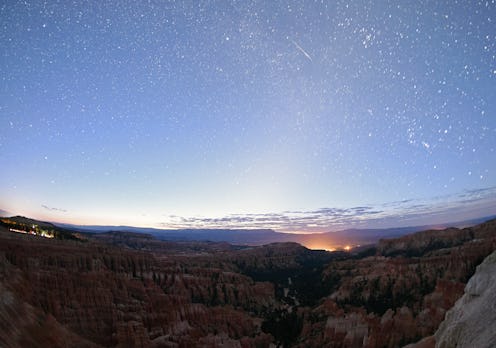If you've been looking forward to another lovely night of stargazing, you're in luck; the Taurid meteor shower is right around the corner, coming to us on Nov. 4 and 5 and Nov. 11 and 12, depending which hemisphere in which you happen to be. So, how can I watch the Taurid meteor shower, you might be wondering? It'll depend on a few factors: The aforementioned hemisphere issue, what your specific area is like, and whether or not you want to be outside or cozied up behind your computer screen, for example. Decisions, decisions. Luckily for us, there are a number of ways to catch the beauty that is the Taurid meteor shower.
According to NASA meteor expert Bill Cooke, who spoke to Space.com in an interview about the Taurids meteor shower, we might only see a few meteors this time round; however, the ones we do see should light up the sky. "In general, the Taurids are very bright," he explained. "So there may be only five per hour, but they are bright. That's their claim to fame." This is important to keep in mind, because our stereotype of what to look for when watching a meteor shower likely involves a ton of shooting stars all across the sky for a short burst of time. The Taurids meteor shower is longer and slower, but the shooting stars you see are basically fireballs of light.
Now that we've reviewed the basics, let's break down your options to actually view the Taurid meteor shower.
If You're In The Northern Hemisphere...
If you're in the Northern hemisphere, your peak viewing time will be Nov. 4 and Nov. 5. According to Cooke, during peak times of the shower, there may be only an incremental increase of how many shooting stars you actually see, so it's important to be in a dark, open location where you have the best view of the entire sky.
If You're In The Southern Hemisphere...
If you're in the Southern hemisphere, your peak viewing time comes later, on Nov. 11 and Nov. 12. It's best to look for the meteors before the full moon on Nov. 14 (which, by the way, will be an historically large supermoon), as the moonlight may interfere with the visibility of the meteors. So if you're in the Southern hemisphere, plan ahead! (Though, technically, the meteor shower will remain active into late November, so do with that what you will.)
If You Want To Watch Outside...
According to Cooke, the best time to see the Taurids will be in the early morning, just before dawn. Just go outside and lie flat on your back so you have a full view of the sky, because there is no specific direction to see the meteors. As usual, avoid tall buildings, lots of artificial light, and so on. No binoculars or special equipment needed!
If you want to see where the meteors will originate, this is also feasible! According to Space.com, the Taurids originate in the constellation Taurus, aka the bull. To find Taurus, simply find the constellation of Orion and gaze to the northeast. There, you'll find Aldebaran, the star in the "bull's eye," which is where the meteors come from. Though they'll pass all throughout the sky, so be sure to look all around!
Happy stargazing, everybody!
Images: Getty Images; Giphy (3)
